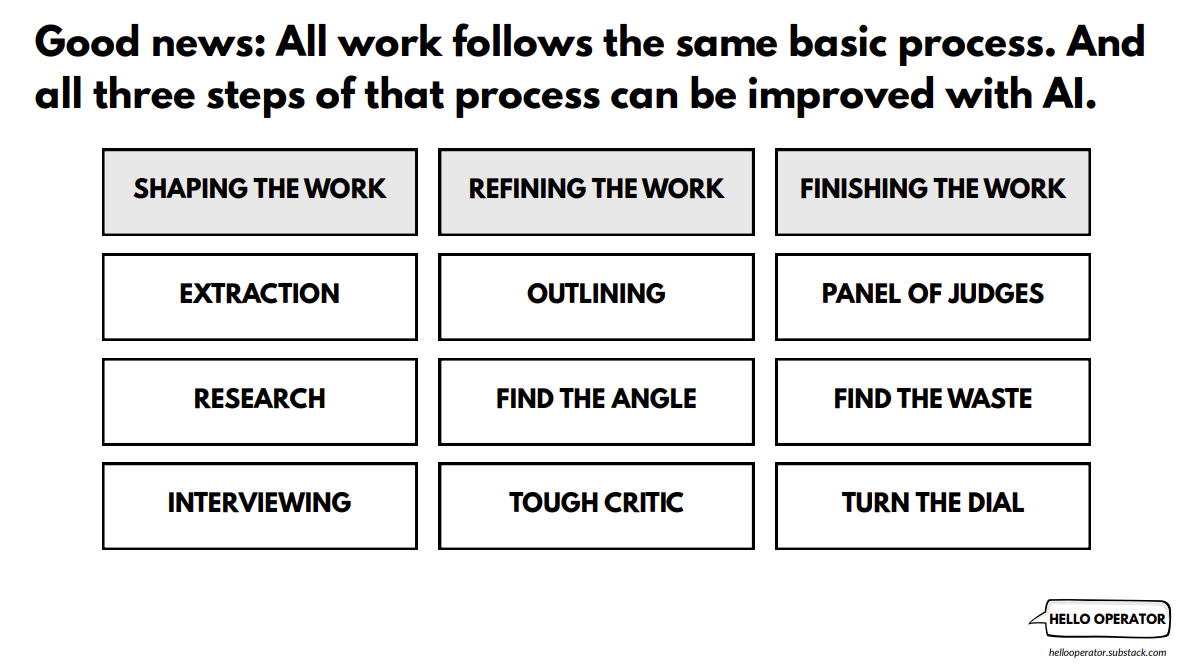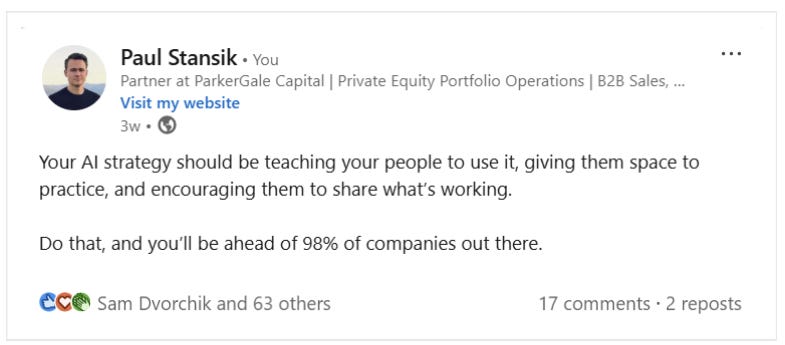How To Put AI To Work
Applying Jobs-to-be-Done to basic AI prompting strategy
Last week, I spoke to a group of executives at World 50 Group about how we're applying AI across our portfolio companies. Here’s a copy of the full presentation I gave:
This wasn’t a speech about theory or where I think AI will be years from now. I wanted to talk about AI from a practical, “here’s what you should be doing right now” perspective. And I wanted to share how we're teaching our teams to use it in their daily work.
Here’s the way I teed up the conversation:
We all just hired the world’s best intern. This intern doesn’t get tired. Doesn’t complain when you ask for the 14th revision at 11:30pm on a Sunday. Doesn’t mind doing the tedious, repetitive, soul-crushing parts of your job. And it works at a speed and level of enthusiasm no human will ever be able to match.
But even the world’s best intern is only as good as the direction you give them.
And that’s where most teams get stuck with AI.
They have the tools. The access. The interest. But when it comes time to actually plug AI into their work, they aren’t sure where to start—or what a good ask for AI even looks like.
Applying Jobs-To-Be-Done To AI
Let’s start with the simplest mental model I’ve found helpful for thinking about AI.
AI isn’t here to replace your judgment. It’s here to compress your cycles.
Think about any meaningful work you’ve done. It didn’t come out perfect on the first try. You shaped it, revised it, circled back, polished it. That’s the process. That’s where quality comes from.
But those iterations take time. And meetings. And energy.
That’s the real promise of AI. Not generating better ideas, but producing better output faster.
What used to take three drafts and multiple days can now happen in 20 minutes. The “figuring it out” that used to stretch across a week can happen in an hour of effective prompting.
You still make the key decisions. You still bring your judgment. But now you have a tool that can instantly execute the next version of whatever you’re working on —so you can reflect on it, react to it, and keep pushing it forward.
Which brings us back to the intern.
Getting value from AI starts the same way you’d get something out of a real-life intern: you have to know what it’s capable of, and you have to give it clear tasks.
This is where I lean on a framework I’ve used for years in product work: Jobs-to-be-done.
Jobs-to-be-done is how we simplify complicated software for our customers and management teams. And I think it’s the best lens out there for making AI more useful at work.
Most of my talk centered on this idea of applying jobs-to-be-done to the prompting process. It’s a two-part idea:
All work is comprised of the same basic jobs.
And all three of those jobs can be improved with the right AI prompt.
Here are the three jobs I’m talking about.
Shaping – Structuring what you’re trying to get done
Refining – Making the first version better
Finishing – Getting it polished and out the door
If you can recognize which phase of work you’re dealing with, it becomes much easier to give AI a better assignment - especially if you’ve already done the work to help your AI know how to match its output to your preferred style.
I’m including my favorite prompt for each job below, but there’s a lot more in the full presentation, including my full jobs-to-be-done prompting framework - screenshotted here and linked again for convenience:
Here’s a few of my favorite prompts from the deck:
1. Shaping: The Extraction Prompt
Use this prompt when you want AI to pull structured insights from messy input (like a call transcript, survey dump, or pile of documents).
2. Refining: "The Tough Critic"
Use this prompt when you want to sharpen your message so it lands with a skeptical or hard-to-impress audience.
3. Finishing: “Turn The Dial”
Use this prompt when you want to fine-tune the intensity of different parts of your writing to land harder, feel sharper, or get out of the way.
The Real Shift
The goal here isn’t just to “use AI.” It’s to get better at noticing the moments when one more iteration would make your work stronger, and then tagging AI in to shoulder the work that next rev will take.
And if you’re thinking about how you can create a team environment more conducive to experimenting with AI, here’s another angle to consider: It’s not just about teaching your team to prompt better - it’s about giving them a framework to help them notice the opportunities to invite AI in, and then creating the space to celebrate and share when they find what works for them.
Thinking about how you can get more out of AI - for yourself, your team, or your company? There’s plenty more on the topic over at my AI 101 page.







Great actionable guidance Paul. Appreciate you sharing so generously.